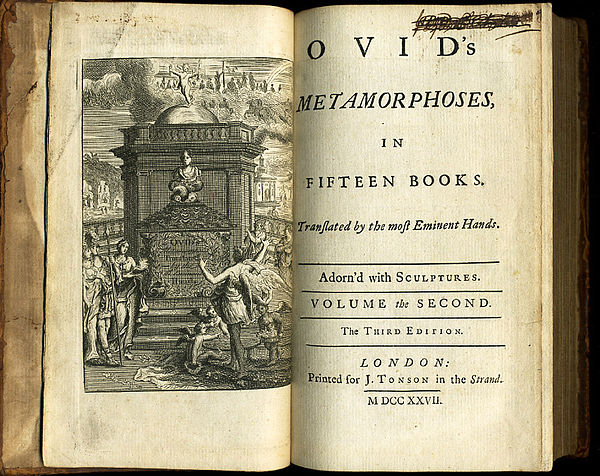More actions
Created page. |
m →Book XV: Fix. |
||
| Line 65: | Line 65: | ||
Book 14 contains the stories of Glaucus and Scylla, the transformation of Aeneas, and the story of Circe and Picus. | Book 14 contains the stories of Glaucus and Scylla, the transformation of Aeneas, and the story of Circe and Picus. | ||
===Book | ===Book 15=== | ||
Book 15 concludes with philosophical reflections on the nature of change and transformation, the deification of Julius Caesar, and a brief autobiographical note from Ovid. | Book 15 concludes with philosophical reflections on the nature of change and transformation, the deification of Julius Caesar, and a brief autobiographical note from Ovid. | ||
{{Epic}} | {{Epic}} | ||
[[Category:Ovid]] | [[Category:Ovid]] | ||
Latest revision as of 08:48, 27 May 2023
Understanding the Structure of Ovid’s Metamorphoses
Metamorphoses is a unique work of literature that combines the form of an epic with the a collection of short stories. Its structure is central to its themes and its narrative technique. This page provides an overview of the structure of the poem, offering insights into how it shapes the narrative and contributes to the meaning of the poem.
Book-by-Book Structure
Metamorphoses is composed of 15 books, each containing several myths linked by the theme of transformation. The stories in each book are not arranged chronologically but are ingeniously interwoven, with one story often leading seamlessly into the next. This structure allows Ovid to explore a multitude of myths and themes, creating a rich and diverse tapestry of stories.

Narrative Technique
Ovid uses a narrative technique known as “ring composition” or “envelope structure,” where a story is bracketed by the beginning and end of another story. This technique allows Ovid to transition smoothly (most of the time) from one story to the next, creating a continuous narrative flow. It also creates a sense of unity and coherence, linking the various stories together.
Thematic Structure
While Metamorphoses does not follow a linear plot, it is structured around recurring themes such as transformation, love, power, and the relationship between humans and gods. These themes provide a unifying thread that runs through the entire poem, linking the various stories and characters together.
Temporal Structure
Metamorphoses spans from the creation of the world to the deification of Julius Caesar, presenting a kind of mythological history of the world. However, the stories are not arranged in strict chronological order. Instead, Ovid often uses thematic or associative connections to transition from one story to the next. This non-linear temporal structure reflects the poem's focus on transformation and change, rather than on a linear progression of events.
Contents Overview
Metamorphoses is composed of 15 books, each containing several myths linked by the theme of transformation. Below is a brief summary of each book, offering a roadmap to the rich and diverse tapestry of stories that make up Ovid’s epic poem.
Book 1
The poem begins with the creation of the world and the four ages of man. It includes several myths, such as the story of Apollo and Daphne, Jove and Io, and the story of Phaeton.
Book 2
Book 2 continues the story of Phaeton and includes other myths such as the transformations of Callisto and Europa, and the story of Mercury and Battus.
Book 3
Book 3 includes the stories of Actaeon, Narcissus and Echo, and Pentheus and Bacchus.
Book 4
Book 4 contains the stories of Pyramus and Thisbe, the daughters of Minyas, and the transformation of Perseus.
Book 5
Book 5 continues the story of Perseus and includes the story of Minerva and the Muses.
Book 6
Book 6 includes the stories of Arachne, Niobe, and the transformation of Tereus, Procne, and Philomela into birds.
Book 7
Book 7 contains the stories of Medea and Jason, Theseus, and the transformation of Cephalus and Procris.
Book 8
Book 8 includes the stories of Daedalus and Icarus, the Calydonian Boar, and the transformation of Baucis and Philemon.
Book 9
Book 9 contains the stories of Hercules, the transformation of Byblis, and the story of Iphis and Ianthe. Hercules, Deianira, & Nessus.
Book 10
Book 10 includes the stories of Orpheus and Eurydice, Pygmalion, and the transformation of Myrrha.
Book 11
Book 11 contains the stories of Midas, the transformation of the daughters of Proetus, and the death of Orpheus.
Book 12
Book 12 includes the Trojan War, the story of Achilles, and the transformation of Caenis.
Book 13
Book 13 continues the story of the Trojan War and includes the transformation of Ajax and Ulysses, and the story of Polyphemus and Galatea.
Book 14
Book 14 contains the stories of Glaucus and Scylla, the transformation of Aeneas, and the story of Circe and Picus.
Book 15
Book 15 concludes with philosophical reflections on the nature of change and transformation, the deification of Julius Caesar, and a brief autobiographical note from Ovid.
